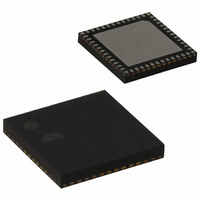EM357-RTR Ember, EM357-RTR Datasheet - Page 217

EM357-RTR
Manufacturer Part Number
EM357-RTR
Description
IC RF TXRX ZIGBEE 192KB 48QFN
Manufacturer
Ember
Specifications of EM357-RTR
Frequency
2.4GHz
Data Rate - Maximum
250kbps
Modulation Or Protocol
802.15.4 Zigbee
Applications
General Purpose
Power - Output
5dBm
Sensitivity
-100dBm
Voltage - Supply
2.1 V ~ 3.6 V
Current - Receiving
26mA
Current - Transmitting
31mA
Data Interface
PCB, Surface Mount
Memory Size
192kB Flash, 12kB RAM
Antenna Connector
PCB, Surface Mount
Operating Temperature
-40°C ~ 85°C
Package / Case
48-QFN
Lead Free Status / RoHS Status
Lead free / RoHS Compliant
Other names
636-1011-2
Available stocks
Company
Part Number
Manufacturer
Quantity
Price
Company:
Part Number:
EM357-RTR
Manufacturer:
SILICON
Quantity:
3 000
Part Number:
EM357-RTR
Manufacturer:
SILICON
Quantity:
20 000
- Current page: 217 of 245
- Download datasheet (12Mb)
12 Trace Port Interface Unit (TPIU)
The EM35x integrates the standard ARM
from the on-chip trace data generated by the standard ARM
data in a FIFO, formats the data, and serializes the data to be sent off chip through alternate functions of the
GPIO. Since the primary function of the TPIU is to provide a bridge between on-chip ARM system debug
components and external GPIO, the TPIU itself does not generate data. Figure 12-1 illustrates the three
primary components of the TPIU.
The TPIU is composed of:
The five pins available to the TPIU are:
Since these pins are alternate outputs of GPIO, refer to Chapter 1, Pin Assignments and Chapter 7, GPIO for
complete pin descriptions and configurations.
Note: The SWO alternate output is mirrored on GPIO PC1 and PC2.
Note: GPIO PC1 shares both the SWO and TRACEDATA0 alternate outputs. This is possible because SWO and
TRACEDATA0 are mutually exclusive and only one may be selected at a time in the trace out block.
The Ember software utilizes the TPIU for efficiently outputting debug data. Altering the TPIU configuration
may conflict with Ember debug output.
For further information on the TPIU, contact Ember support for the ARM
Manual, the ARM
Reference Manual, and the ARM
Asynchronous FIFO: The asynchronous FIFO receives a data stream generated by the ITM and enables the
trace data to be sent off chip at a speed that is not dependent on the speed of the data source.
Formatter: The formatter inserts source ID signals into the data packet stream so that trace data can be
re-associated with its trace source. Since the EM35x has only one trace source, the ITM, it is not necessary
to use the formatter and therefore the formatter only adds overhead into the data stream. Since certain
modes of the TPIU automatically enable the formatter, these modes should be avoided whenever possible.
Trace Out: The trace out block serializes the data and sends it off chip by the proper alternate output
GPIO functions.
SWO
TRACECLK
TRACEDATA0
TRACEDATA1
TRACEDATA2
TRACEDATA3
®
CoreSight
TM
Components Technical Reference Manual, the ARM
®
v7-M Architecture Application Level Reference Manual.
Figure 12-1. TPIU Block Diagram
®
Trace Port Interface Unit (TPIU). The TPIU receives a data stream
Final
12-1
®
Instrument Trace Macrocell (ITM), buffers the
®
Cortex
EM351 / EM357
TM
®
-M3 Technical Reference
v7-M Architecture
120-035X-000G
Related parts for EM357-RTR
Image
Part Number
Description
Manufacturer
Datasheet
Request
R

Part Number:
Description:
MODULE EM357 PA/LNA W/ANT TG
Manufacturer:
Ember
Datasheet:

Part Number:
Description:
MODULE EM357 NO PA/LNA W/ANT TG
Manufacturer:
Ember
Datasheet:

Part Number:
Description:
MODULE EM357 NO PA/LNA W/RF CONN
Manufacturer:
Ember
Datasheet:

Part Number:
Description:
MODULE EM357 PA/LNA W/RF CONN
Manufacturer:
Ember
Datasheet:

Part Number:
Description:
IC RF TXRX ZIGBEE 192KB 48QFN
Manufacturer:
Ember
Datasheet:

Part Number:
Description:
KIT DEV EMBER ZIGBEE W/PCWH
Manufacturer:
Custom Computer Services Inc (CCS)

Part Number:
Description:
PROGRAMMER USB FLASH EM250/260
Manufacturer:
Ember
Datasheet:

Part Number:
Description:
IC ZIGBEE SYSTEM-ON-CHIP 40-QFN
Manufacturer:
Ember
Datasheet:

Part Number:
Description:
IC ZIGBEE SYSTEM-ON-CHIP 48-QFN
Manufacturer:
Ember
Datasheet:

Part Number:
Description:
IC RF TXRX ZIGBEE 128KB 48QFN
Manufacturer:
Ember
Datasheet:

Part Number:
Description:
INSIGHT ADAPTER FOR EM2XX
Manufacturer:
Ember
Datasheet:

Part Number:
Description:
PROGRAMMER USB FLASH EM250/260
Manufacturer:
Ember
Datasheet:

Part Number:
Description:
IC ZIGBEE SYSTEM-ON-CHIP 40-QFN
Manufacturer:
Ember
Datasheet:

Part Number:
Description:
IC ZIGBEE SYSTEM-ON-CHIP 48-QFN
Manufacturer:
Ember
Datasheet:

Part Number:
Description:
IC RF TXRX ZIGBEE 128KB 48QFN
Manufacturer:
Ember
Datasheet:











